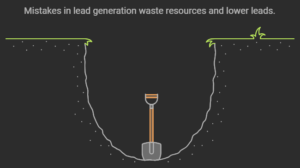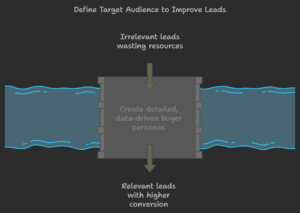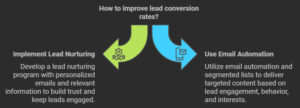Lead generation today is highly important in the competitive market because it brings in potential customers directly to your brand, which lays the foundation for conversion and long-term customer relationships. Lead generation, therefore, attracts prospects but nurtures them all through the buying process so that initial interest is converted into loyalty. However, though most businesses invest in lead generation, they typically make major but avoidable mistakes that sabotage their efforts. This includes things such as never attempting to qualify their ideal target audience or using only organic techniques as a strategy. All of these waste resources and lower the quality of leads, affecting return on investment.

The good news is that all of these common pitfalls can be corrected with proper strategies. This blog will take you through the five most common lead generation mistakes and provide practical solutions for each.
Mistake 1: Not Defining Your Target Audience Clearly

Problem
Without an identified target audience, the generated leads are eventually without a focus on them. It hence often leads to irrelevant people who may seem interested but don’t really convert or even maintain long-term engagement. The danger of unclear definitions of who is being targeted is spending lots of time, money, and energy on leads that have no added value to your business.
Fix
It is very crucial to create a detailed, research-based, and data-validated buyer persona to attract the right leads. A buyer persona is a semi-fictional representation of an ideal customer covering demographics, behavior patterns, preferences, and pain points. It can help one understand the target audience in a better way and also design campaigns that are specifically resonating with them.
Actionable Tip
Continue drilling down, using analytics tools like Google Analytics, social media insights, and CRM information. The data analysis refines and validates buyer personas; thus, you can properly craft messaging and content that speak directly to the ideal audience, increasing relevant leads’ chances to convert.
Mistake 2: Relying Solely on Organic Methods Without Paid Campaigns

Problem
Organic lead generation is not sufficient, especially in highly competitive industries where visibility is paramount. Organic techniques like content marketing, SEO, and social media engagement are irreplaceable tools to create credibility and a loyal following. However, organic growth is slow, and its reach has a limit because of algorithm changes and high competition that makes it challenging to have new leads every day.
Fix
To overcome these constraints, you need to engage in both organic and paid campaigns like PPC ads or social media advertising. Paid campaigns allow you to have the upper hand in zeroing in on a defined audience, that is based on demographics, interests, and behaviors, hence your content reaches a wider, more relevant audience much more quickly. It’s truly something that will complement organic efforts through improved visibility as well as bringing leads to you who might not have otherwise landed on you.
Actionable Tip
An easier approach would be to start off small and invest a low budget into advertising. Test out a few different ads. Once you know your ads, and they’re converting, increase the budget if that is feasible. With that model, you maximize where you spend, stay balanced in your organic vs paid lead, and have more reach along with full lead capacity.
Mistake 3: Lack of a Lead Nurturing Strategy

Problem
Most lead generation errors occur after the original lead engagement has been neglected in terms of nurturing them further. Most leads don’t buy on the very first engagement, and others will require time and exposure to information to feel confident before making a purchase. Absent a clear nurturing program, most potential leads lose interest and default to other competitors – another missed opportunity.
Fix
This will help you have a lead nurturing funnel with constant follow-through, personalized emails, and the right, high-value information about their interest or needs. You will keep on feeding them the relevant information, and you’ll ultimately create trust for your leads over time. With the nurturing strategy, you would be able to assist them in moving forward along the journey of buying until finally decide to buy, making them step by step ready for this.
Actionable Tip
An effective way of applying this is through the use of email automation and segmented lists to deliver personalized content at different stages to the lead. By using segmentation, one can send targeted messages to factors such as the level of engagement, behavior, or even interests. For instance, a lead in the awareness stage will require educationally tailored content, while the other leads closer to conversion will need case studies or some special offers. The personalized approach maximizes the likelihood of converting initial interest into meaningful customer relations.
Mistake 4: Poor Landing Page Optimization

Problem
A poorly optimized landing page can be the biggest barrier to lead generation. When visitors land on a page that is too cluttered, confusing or lacks a clear CTA, they will bounce away without taking action. Such problems include overwhelming layouts, slow loading times, or hard-to-find CTAs lacking urgency to take action.
Fix
The fix would be making your landing page’s design simple and clear. Moreover, your CTA should go where everyone can view it clearly; it has to stand out so that the lead will find it in line with the intent. This is an easy way of refining the user experience and engaging by removing visual clutter and improving load speed while letting the CTA pop. Simply stated, every element on the page must drive the visitor to one single action: he could be signing up downloading, or maybe scheduling a call.
Actionable Tip
Test through further refining results by A/B testing. Test through headlines, images, the text in your CTA, the color of the button, and anything your landing page makes up, as A/B testing reveals what variations make more sense to your visitors; this will help your website landing pages improve incrementally with real user feedback while progressively increasing conversions.
Mistake 5: Not Tracking and Analyzing Lead Data

Problem
Another common mistake in lead generation is not tracking and analyzing the lead data. Without analysis, it is almost impossible to measure which tactics are working and which ones need improvement. Data allows you to know the lead sources, conversion rates, and overall campaign performance; hence, you understand from where your leads come and what drives them to convert. In this regard, without it, you will end up wasting precious time and effort in strategy development that does not significantly benefit you at all and instead leaves potential avenues untapped.
Fix
Now is the time to correct such a problem using analytic tools such as Google Analytics or CRM software or lead-tracking service providers that will help follow up with lead generation activity. For instance, it is achievable to use such tools to deduce the channels and the campaigns responsible for the greatest quality leads from those who failed to hit the mark. For example, the tracking of a lead source may state that PPC campaigns work more effectively than that of the social media ads while, on the other hand, email marketing produces higher results than that of the blog content in terms of engagement.
Actionable Tip
Practical and regular review for improvement in key metrics of clicks, quality score, and conversion is the most logical thing that can be done with existing data to force every click to the optimum using such data. It leads towards informed changes to what’s being done or continuing in what thrives the most. Through continuous refinement based on real insights over time, you can enhance the effectiveness of your lead generation efforts much more significantly, with more precision and efficiency to attract and convert leads.
Conclusion
All are part of digital marketing competition in the present time, which is most critical for winning in the long run and avoiding some of the main lead generation mistakes. With each mistake—from failing to define a target audience and relying only on organic methods to having no nurturing strategy, landing page optimization strategy, or no tracking system for your lead data —you lose the potential to achieve valuable leads and convert the same leads into loyal customers. Knowing this and implementing them through pragmatic solutions will back a lead generation strategy that is significantly better and efficient.
Those implementations will make the quality of your leads better and optimize the spend at once, meaning reaching the target audience at the right moment in time. With improvements in building well-researched buyer personas, incorporating paid ads, all the way to nurturing with tailored content and continuously analyzing data-you get that much closer to achieving a sustainable high-performing lead generation process.
Take these nuggets as a starting point from which you can go. Remember lead generation is a continuous activity. Refine it daily based on how it affects everything around it. Start taking your improvements and tweaking their results. Be watching what seems to fit, so be sure that the experiment leads you to achieve higher efficiency.
